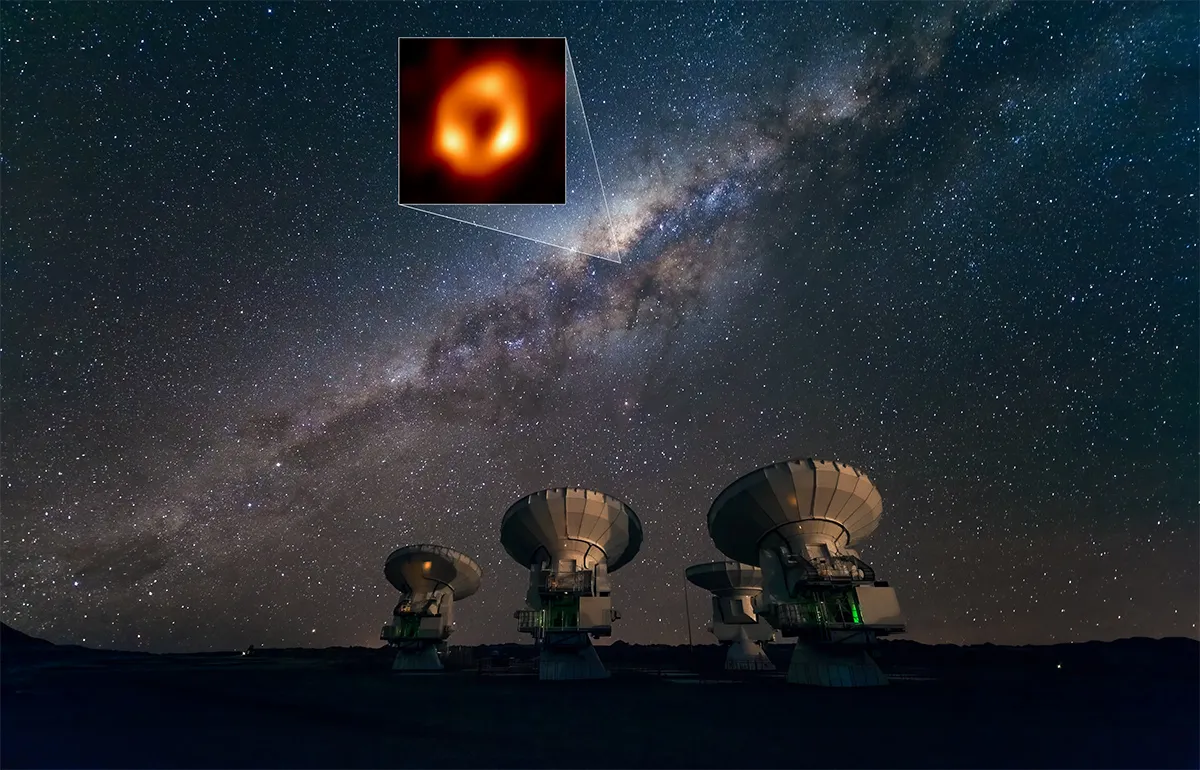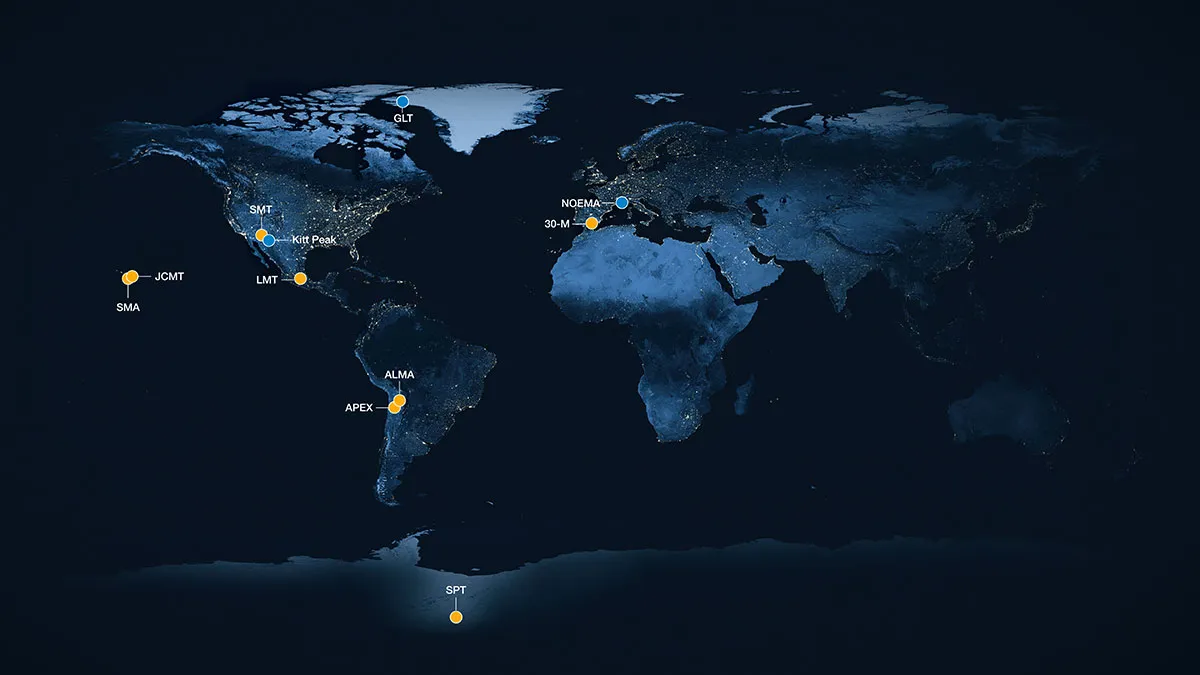Last week, on Thursday 12 May, the Event Horizon Telescope Collaboration revealed the first-ever image of Sagittarius A* (Sgr A*), the black hole in the centre of our Galaxy, the Milky Way.
This remarkable image comes three years after the very first image taken of a black hole, which shows M87*, the black hole at the centre of the galaxy M87. The two images look similar, despite the differences between the two black holes: at four million times the mass of the Sun, Sgr A* is a thousand times less massive than M87*. Imagine looking for a doughnut on the surface of the Moon from Earth: that's the amount of area of the sky that Sgr A* takes up.
The image also represents the most compelling evidence yet that Sgr A* is indeed a supermassive black hole.
What does the image show?
Technically, you can't take a photo of a black hole itself – after all, the whole point is that no light can escape. The glowing orange ring in this photo shows the matter surrounding Sgr A*, with the 'shadow' in the centre showing the black hole itself.
A black hole has an incredibly strong gravitational pull, and will drag any nearby gas and dust into orbit around it. As this material swirls inwards at nearly the speed of light, friction heats it up and it emits energy in the form of radio waves. The Event Horizon Telescope, which detects radio frequencies, picks this up and registers it as a bright halo around the black hole.
The final image is the result of several individual shots averaged together.
Where is Sagittarius A*?
Sagittarius A* is in the centre of our Galaxy, the Milky Way. From Earth, we can see it in the Sagittarius constellation, and it's over 26,000 light-years away.
How does the Event Horizon Telescope work?
The Event Horizon Telescope is often referred to as an 'Earth-sized telescope' and as a 'virtual telescope'. But what exactly does this mean?
In astronomy, the bigger the telescope, the better. An amateur's telescope with a 60mm lens will show you a decent view of the Moon's surface or even Jupiter and Saturn, whereas the Hubble Space Telescope’s 2.4m mirror produces stunning images of nebulae and galaxies. Meanwhile, the newly launched James Webb Space Telescope has a mirror diameter of 6.5m, and the primary mirror of the upcoming Earth-based Extremely Large Telescope is 39 metres across.
Hubble, James Webb and the ELT are all fantastic feats of engineering, and yet their mirrors are nothing compared to the Event Horizon Telescope. By linking together 11 telescopes around the world, the EHT can effectively create one telescope with a mirror the size of the Earth.

This virtual telescope is incredibly powerful. It's the equivalent of sitting in a beer garden in Munich, and seeing the bubbles in a beer glass in New York.
“While the Earth is rotating, all telescopes observe the same astronomical object for several hours," explained Thomas P Krichbaum at the press conference at European Southern Observatory headquarters near Munich. "At each telescope, the data are recorded on hard disks and are accurately time-tagged by precise atomic clocks. After observations, the data are shipped to processing centres where they are combined in supercomputers.
"After a number of quite complex data analysis steps, this results in the high-resolution image of the radio source.”
Why did it take so long after the picture of M87*?
All the observations for both black hole pictures were done in 2017, so it seems bizarre that it should take up to five years for the public to get to see the images.
This is because observing through the EHT is not like looking through a reflecting telescope in your garden. What you get back is reams and reams of data that must be analysed and processed before it becomes an image.
The image of Sgr A* was even harder to produce than the one of M87*. “The gas in the vicinity of the black holes moves at the same speed — nearly as fast as light — around both Sgr A* and M87*," said Chi-kwan Chan, EHT scientist based at the University of Arizona, USA.
"But where gas takes days to weeks to orbit the larger M87*, in the much smaller Sgr A* it completes an orbit in mere minutes. This means the brightness and pattern of the gas around Sgr A* were changing rapidly as the EHT Collaboration was observing it — a bit like trying to take a clear picture of a puppy quickly chasing its tail.”

What does this image tell us about the science of black holes?
“We were stunned by how well the size of the ring agreed with predictions from Einstein’s Theory of General Relativity," said EHT Project Scientist Geoffrey Bower from the Institute of Astronomy and Astrophysics, Academia Sinica, Taipei. "These unprecedented observations have greatly improved our understanding of what happens at the very centre of our Galaxy, and offer new insights on how these giant black holes interact with their surroundings."
Black holes represent the extremes of what General Relativity can describe, and in the future, the EHT will scour them for the point when the theory breaks down.
Why is it called Sgr A*?
When it was first discovered, astronomers didn't know what was creating the mysterious radio signal at the centre of our Galaxy. So, due to its location in the constellation of Sagittarius, the radio source was named Sagittarius A.
Later observations showed that Sagittarius A is actually made up of three components, the most notable of which is the bright, compact object at the centre. Robert Brown, who discovered this particular object with Bruce Balick in 1974, named it Sagittarius A* to distinguish it from Sagittarius A as a whole.
Brown is said to have chosen the name because the discovery was exciting, and the symbol '*' is an existing notation in physics to represent an atom in an 'excited' state.
What's in the future of the EHT?
EHT is in the process of undergoing significant technical upgrades. Observations in March 2022 included more radio telescopes than ever before, and future releases may even include movies of black holes.
Why is there a supermassive black hole in the centre of the Milky Way – and should we be worried?
Almost every known large galaxy has a supermassive black hole at its centre – however, it's not yet known whether galaxies formed around a black hole seed, or whether the centre of the galaxies collapsed into black holes. The existence of supermassive black holes at all is still a mystery: how did they grow to such an enormous size, even in the early Universe?
Either way, don't worry: we're not going to get sucked into Sgr A* any time soon. Black holes don't 'eat' matter as such – they just have a lot of mass, so their gravitational pull is particularly strong. We'd orbit around the centre of our Galaxy just the same if the black hole were replaced any other object with the same mass.
Read more about black holes:
